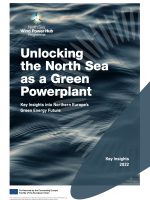Unlocking the North Sea as a Green Powerplant
In this publication, we share five key insights that we believe will be crucial to unlocking the true potential of the North Sea.
The North Sea is a massive, shared resource. A powerhouse of wind energy with enormous potential to benefit the whole of Europe. That can help drive energy independence in light of a challenging supply situation and war, and help us rely more on sustainable sources.
Right now, key decisions are being made. They will determine the offshore energy capacity for the next 25 years and define our response to climate change.
No one country around the North Sea can deliver the comprehensive and integrated solution we need. We are facing a 180 GW offshore wind integration in the European energy system – renewable energy at a scale never seen before. To succeed, we need to go beyond. Beyond what works for smaller quantities, and beyond borders, to create a novel approach.
A solution is at hand. With a hub-and-spoke-model, we believe we have the best way to link together the power systems of Northern Europe in one wellplanned
network. The hub-and-spoke-model allows for an internationally coordinated and modular buildout that achieves three vital tasks that the future green power plant in the North Sea must be able to perform:
• Collect vast amounts of offshore wind power generated at wind farms and energy islands in the North Sea at a few decentralised hubs.
• Connect these hubs in a flexible network that spans the North Sea and can supply power deep into the European mainland to supply millions of consumers with green energy.
• Convert surplus electricity to hydrogen to expand the uses of the green power and reduce CO2 emissions from heavy industry, transport and more.
We don’t have all the answers for how to do this yet, but we are making important progress. In this publication, we share five key insights that we believe will be crucial to building this future hub-andspoke system. For instance, we are moving closer to identifying the most efficient pathways to bring the vast energy resources of the North Sea onshore through a coordinated roll-out with multiple energy connections between North Sea countries.
We are also developing a much clearer picture of how to build a modular system, where different functionalities can be fit together like LEGO bricks and allow us to start building today without losing the option to include new and improved technologies in the future.
The key choices that shape our response to the climate challenge are being made right now. There is no scope for short-sighted or haphazard decisions. We need a long-term view, a common blueprint based on thorough analysis, and clear common goals to guide us to 2030 and beyond.
The five insights in this publication are part of a much wider work. For more, please see our Feasibility Study Report published in the fall of 2022. We also continuously provide new research and publications.
The Five Insights
One exciting aspect of the build-out in the North Sea, aside from the ambitious scale, is all the new building bricks. New technologies and new physical structures will go into the design in a way we don’t have anywhere in the world today.
Decades ago, European countries invested in roads and freeways that brought the continent together and allowed people to travel between countries quickly and safely. Since that time, traffic volume has exploded, and capacity is reaching its limits. This is true not just for roads, but in a figurative sense also for the energy infrastructure.
When building the North Sea green power plant, we are building for both now and the future. We can already anticipate significant technological leaps over the coming years, making new solutions available to generate, convert, and transmit energy
The green power plant in the North Sea must be able to convert electric power to hydrogen fuel. This is crucial, especially on very windy days or at times of low immediate electricity demand when there is a surplus of wind energy in the system. Hydrogen is also vital if we are to achieve carbon-neutral industry and other sectors.
No one country can deliver the comprehensive and integrated solution that will realise the full potential of the North Sea. This is true for the technical build- out and, as it turns out, it is also true for how the energy market is set up.

